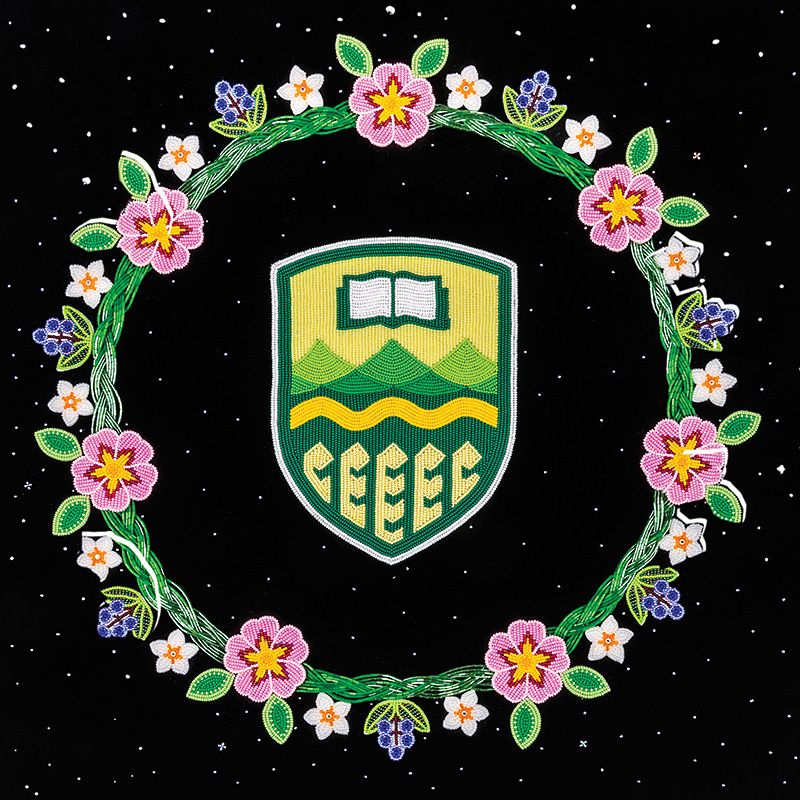She had already unstitched the beads once because the colours weren’t right. Tara Kappo, ’15 BA(NativeStu), ’15 Cert(IndigGov/Ptnshp), ’21 MA, just couldn’t find the right ones for the wild roses she was trying to make.
Then she remembered the small wooden chest that had belonged to her late maternal grandmother, Mary Kappo — or Gran, as Kappo calls her. The chest contained her grandmother’s bead collection, which was given to Kappo after Gran passed away. Kappo had planned to use the beads to make moccasins for her family to continue Gran’s legacy. But struggling to find the right beads for the roses, she turned to the chest.
“There was a vial of pink beads that, as soon as I saw them, I went, ‘These are the ones I need to use,’” she says. “And as soon as I picked them up and I started again, everything just came together.”
Kappo, who is Woodland Cree from Sturgeon Lake Cree Nation in Treaty 8 territory, was already working on her master’s thesis when the university commissioned her to create a beaded University of Alberta crest. It was the wild roses she wanted to include that called for the particular shade of pink.
The connection Kappo felt to the beads in that moment would become a core part of her written master’s thesis, mîkistahikâcimo (to tell a story through beadwork).
Through the beadwork and her thesis, she learned many lessons. Here are four of them.
1. Beads are animate beings
Kappo used the U of A crest — titled kiskinohawmatok, learning together through sharing — as a jumping off point to explore what beadwork does and is, and how it’s connected to practices of Indigenous law and governance, especially nîhiyaw, meaning Cree.
“In approaching beadwork through nîhiyaw pimâtisowin, the Cree way of life, beads are understood as animate, other-than-human beings with whom beadwork artists have relationships of co-creation,” Kappo explains in her thesis.
2. More than a design
Kappo wanted to focus on things that people in Alberta living under treaty have in common, starting with the land we all live on, which was already part of the U of A crest in the form of the river, prairies and mountains.
She chose the wild rose because it’s found in Cree and Métis beadwork and is also Alberta’s provincial flower. The other plants in the design are wild strawberry flowers, blueberries and sweetgrass, all of which are medicines and represent Indigenous knowledge. In nîhiyawak philosophical thinking, the plants, like the beads, also have a spirit. The indigo velvet background and clear beads scattered overtop represent stars in the universe and the space we all share.
3. Beading links the present to the past
The velvet backing of the beadwork is significant for Kappo because it’s a common Métis beading fabric and both her adoptive and paternal grandmothers were Métis.
Kappo remembers watching her Gran bead. “I just remember kind of hanging around her and watching her as she was beading,” she says, “so I had an idea of how to approach things.”
Kappo’s paternal grandmother, Agnes Cardinal, also did beadwork, as did her maternal grandfather’s grandmother, Madeline Mikkomusus. And Kappo’s adoptive grandmother, Granny Elizabeth Flett, had a collection of beads that fascinated Kappo.
“She encouraged me to learn how to bead by saying that she was giving me that collection of beads, but I could only take it home once I showed her that I knew how.” The beads went to someone else when Granny Flett died, but Kappo kept her promise to learn.
“I’m really reluctant to say that I’m self-taught because I don’t think that’s necessarily the case,” she says. “I firmly believe that that style of learning things — through observation and then hands-on getting in there — that is a method.”
She recalls one day when she told Gran: “Beading is my medicine.” Her grandmother appeared stunned and told her that Mikkomusus, Kappo’s great-great-grandmother, used to say the very same thing.
4. Creativity and research can work together
While working on the U of A crest, Kappo realized that beading could become a research methodology. By taking a research creation approach, she incorporated the process of working on kiskinohawmatok into her research and understanding of beading.
“When I finished the work, I realized that not only had it been generative for my academic pursuits, in effect it was the research and the writing of my thesis,” Kappo notes in her thesis.

We at New Trail welcome your comments. Robust debate and criticism are encouraged, provided it is respectful. We reserve the right to reject comments, images or links that attack ethnicity, nationality, religion, gender or sexual orientation; that include offensive language, threats, spam; are fraudulent or defamatory; infringe on copyright or trademarks; and that just generally aren’t very nice. Discussion is monitored and violation of these guidelines will result in comments being disabled.